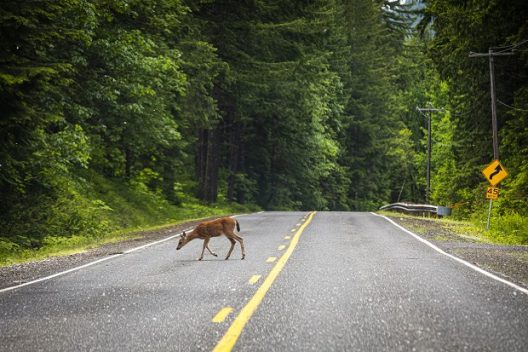ESRM: Wildlife Conservation Academic Requirements
 Wildlife Conservation is the science and art of managing animal populations and their related resources. In the ESRM: Wildlife Conservation Option, for their final 46 credits of degree requirements, students complete coursework in wildlife ecology, quantitative science, and the social and political aspects of wildlife conservation issues. Students can expect hands-on field experiences including how to identify, capture, and handle animals; and how to assess, map, and plan wildlife habitats. Instruction on writing technical reports and scientific papers, and presentation of findings and implementation of wildlife conservation plans will be covered.
Wildlife Conservation is the science and art of managing animal populations and their related resources. In the ESRM: Wildlife Conservation Option, for their final 46 credits of degree requirements, students complete coursework in wildlife ecology, quantitative science, and the social and political aspects of wildlife conservation issues. Students can expect hands-on field experiences including how to identify, capture, and handle animals; and how to assess, map, and plan wildlife habitats. Instruction on writing technical reports and scientific papers, and presentation of findings and implementation of wildlife conservation plans will be covered.
Students earn a B.S., Environmental Science and Terrestrial Resource Management. The Option in Wildlife Conservation is noted on student transcripts only, not the diploma.
Schedules
Schedules are available over on the Academic Planning Resources page.
Required Wildlife Conservation Option Courses
All pathways in ESRM require the same set of ESRM Core courses, UW General Education requirements, and fundamental Science, Math, and Social Science course content. The only distinction is in the final set of upper division course requirements (40-55 credits, depending on the pathway chosen and the classes selected within that pathway).
Required Wildlife Conservation Option Courses
ESRM 350 (5) Wildlife Biology and Conservation
ESRM 351 (5) Wildlife Research Techniques
ESRM 441 (5) Landscape Ecology
ESRM 450 (5) Wildlife Ecology and Conservation
ESRM 451 (3) Analytical Methods in Wildlife Science
ESRM 458 (5) Management of Endangered, Threatened and Sensitive Species
Need one course:
QSCI 482 (5) Statistical Inference in Applied Research
Choose one from the following list (3 credits minimum):
ESRM 452 (3) Field Ornithology
ESRM 453 (3) Ecology and Biology of Mammals
ESRM 459 (3) Wildlife Conservation in NW Ecosystems
Senior Capstone
Completing a Senior Capstone is required for the Wildlife Conservation option. Wildlife Conservation students may choose any of the three capstone options. Go to the Capstone page for more Capstone details.
Minors to Consider
Suggested: Completing the Quantitative Science Minor- 27 credits
*Many of the credits for this minor are completed through the required wildlife coursework
A minor in quantitative science is recommended for graduate study. See more on this minor here.
Career Opportunities and Graduate Study
With the bachelor’s degree and relevant experience, career opportunities include working as entry-level wildlife managers, naturalists in national or state parks, or as field biologists for agencies and environmental consulting firms. Most professional positions in the wildlife field require a graduate degree and this option offers strong preparation for subsequent graduate work. Public agencies, such as the Washington State Department of Fish and Wildlife, the Washington State Department of Natural Resources, the Washington State Department of Ecology, the U.S. Forest Service and the U.S. Fish and Wildlife Service, hire wildlife professionals as do private sector environmental consulting firms, forest industry, and conservation organizations. The option also is an appropriate choice for students interested in subsequent professional degrees in public policy or environmental law.
SEFS and Affiliated Faculty
Beth Gardner (lead), Sarah Converse, Joshua Lawler, Alex McInturff, L. Monika Moskal, Laura Prugh, Sandor Toth, and Aaron Wirsing.